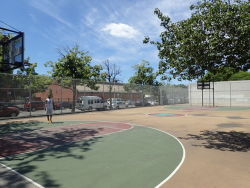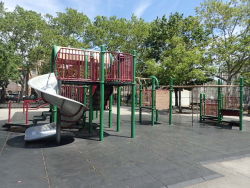Jackie Robinson Park Playground
Jackie Robinson Park
What was here before?
This site was once occupied by several one-story commercial buildings that housed a blacksmith, a bookstore, a flooring shop, and a carburetor manufacture, as well as residential buildings ranging from single-family, detached homes to four-story apartment buildings.
How did this site become a playground?
In 1954, the City of New York acquired this property, and the Board of Education assumed control over the site. The park opened in 1959 as the Public School 21 (Crispus Attucks School) Playground. In 1970, as the Board of Education looked to expand P.S. 21, Parks relinquished its control over P.S. 21 Playground.
That same year, the Department of Housing Preservation and Development (HPD) developed a new one-acre playground on the block, which later incorporated a portion of the old P.S. 21 Playground. In 1981, this playground was assigned to Parks. Parks, in turn, designated the property Jackie Robinson Park Playground to recognize the work of the local Jackie Robinson Development Corporation at the park.
During a renovation of the park in 1988, the park’s large baseball field was replaced with four new tennis courts.
Who is this playground named for?
This playground honors former Dodger Jackie Robinson (1919-1972), the first African-American Major League Baseball player. Robinson was born in Cairo, Georgia, and raised in Pasadena, California. Robinson's athletic prowess became evident at the University of California, Los Angeles, where he became the first student to letter in four sports: baseball, basketball, football, and track. Robinson played professional football for the Los Angeles Bulldogs before serving in the army during World War II.
After the war, Robinson played baseball in the Negro Leagues for the Kansas City Monarchs, where he caught the eye of Branch Rickey (1881-1965), general manager of the Brooklyn Dodgers. Rickey signed Robinson on August 28, 1945 to join the Montreal Royals, the Dodger’s Triple-A affiliate in the International League. For two years, Robinson toiled in the minor leagues. On April 15, 1947, Robinson made history as the first Black to play in a Major League baseball game, paving the way for generations of black athletes to compete in America's national pastime.
Renowned as a top-notch second baseman and a fierce competitor, Robinson led the Dodgers to six World Series appearances. He retired in 1956 with a lifetime batting average of .311, and was inducted into the National Baseball Hall of Fame in 1962. Robinson served as Vice President of Personnel for the Chock-Full-O' Nuts restaurant chain for several years, and was involved with a number of Black-owned community enterprises such as Freedom National Bank, which he co-founded. He also became active in the National Association for the Advancement of Colored People (NAACP), and served as a special advisor to New York Governor Nelson A. Rockefeller (1908-1979). Robinson died of a heart attack at his home in Greenwich, Connecticut in 1972.
Check out your park's Vital Signs
Clean & Safe
Green & Resilient
Empowered & Engaged Users
Share your feedback or learn more about how this park is part of a
Vital Park System



